News and Highlights
This is a list of past iUTAH EPSCoR news from 2012 to 2018.
May 15, 2018
Student Honors for Outstanding iFellows
iUTAH wants to congratulate graduates across the state, and highlight the outstanding achievements by a few of the undergraduates that lined up to receive their hard-earned degrees this May.
Southern Utah University conferred a degree on Donald Long. A recent article in The Independent by SUU writer Nikki Koontz described Long’s journey from homelessness to first-generation college graduate, highlighting his “deeply rooted thirst to engage in research.” Mentored by Fredric Govedich, SUU department chair of biology, among others, he was involved in four major research projects, including the iFellows undergraduate research fellowship program.
As part of the 2015 iFellows cohort, Long researched the effects of nutrients and pharmaceutical pollution on stream biofilms, later presenting this research at national conferences alongside Beth Ogata, Zach Aanderud, and Michelle Baker. Koontz said that “Long will graduate this May with a double major in biology and nutrition and a minor in chemistry. He will take the MCAT and start applying for medical schools this fall with the goal to study internal medicine. During his gap year, Long has plans for a post-baccalaureate program, which entails a year of intensive research at an R-1 institution.”
Utah State University recognized two past iFellows undergraduate researchers, Lindsay Capito, 2017, and Jesse Fleri, 2015. Capito was named Outstanding Senior of the Year for the Watershed Sciences Department. She plans to continue her education at USU as a graduate student, studying Didymosphenia geminata, also known as ‘Didymo’ or ‘rock snot,’ and a possible connection to glacier recession.
Also from the Quinney College of Natural Resources at USU, Jesse Fleri, graduated with Honors and was recognized with the Peak Prize: Undergraduate Researcher of the Year. The future looks wet for Fleri as he continues to pursue projects in aquatic and marine environments. He says “I am fascinated by changes happening over large spatial extents and really enjoy the complexities that inherently come with working in dynamic systems.” To this end, he will be moving to Canada later this summer to continue his studies as a graduate student funded by the University of British Columbia, and conduct research throughout the San Juan and Gulf Islands to understand how bottom-up and top-down trophic cascades are inhibiting the conservation and restoration of Garry Oak ecosystems.
Fleri says of his experience as an iFellow that it “taught me a lot about what I wanted out of an adviser, a lab, and a project. It was great being forced to completing a project over a single summer because you have to learn about all the stages of research. I learned that water chemistry was not a field I would want to pursue and that my interests were more biology or physics based but I couldn't have known that prior to that summer.”
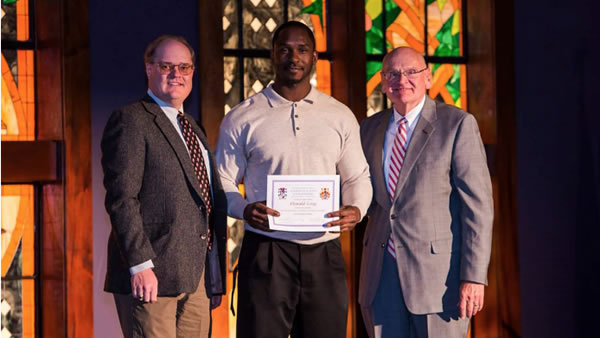
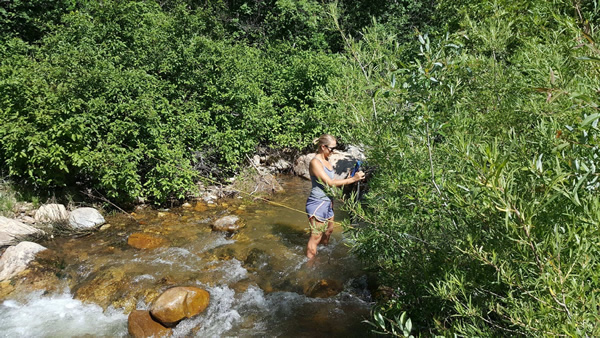
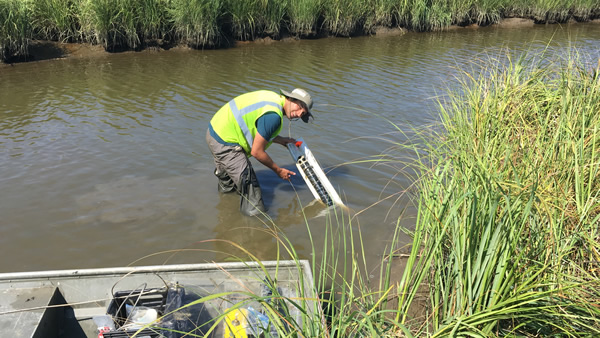
April 16, 2018
Bean Museum Involves Visitors in Local Watershed
The Bean Life Sciences Museum, located on the Brigham Young University campus, has partnered with iUTAH and the Natural History Museum of Utah to place an interactive display in the museum to help visitors learn about their local watershed. Based on a display developed by NHMU in 2015, the Bean Museum’s version allows visitors to see and interact with live data collected from the Provo River watershed.
The exhibit uses the iUTAH network of aquatic and climate sensor stations from GAMUT, which stands for “Gradients Along Mountain to Urban Transitions.” GAMUT sensor stations, located in three of Utah’s most populated watersheds: Red Butte Creek, Logan River, and Provo River, traverse the landscape from mountain to urban settings. Data from these stations are monitored and used for solving a wide range of water-related problems. From diagnostics and restoration of impaired urban rivers to modeling future water availability, the data help identify irregularities in Utah’s waterways.
Installed in February 2018, the display has been well received offering visitors the opportunity to explore the Provo River without leaving the comforts of a warm museum building. Visitors can become researchers, seeing and comparing changes in water levels and temperatures in real-time. They also learn to be water-wise citizens as they gain a better understanding of the impacts of pollution and population on their watershed.
“The Provo Watershed exhibit has been a great resource to teach kids about how different properties of water affect the wildlife,” said Meagan Grasley, an educator at the Bean Museum. “Children have loved looking at the different wildlife that live at each part of the watershed. Overall, it has brought more awareness to the patrons of their local ecosystem.”
This interactive display at the Bean Museum is just one of the many examples of legacy products that will be available for research and education long after the iUTAH project ends in July 2018.
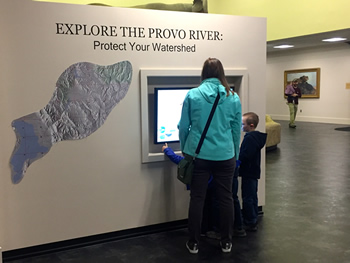
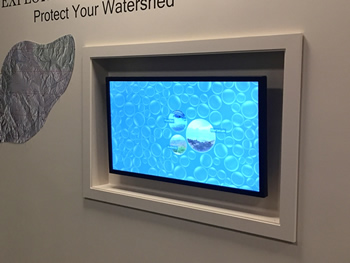
April 10, 2018
Aerial Imagery Gives Insight into Water Trends
iUTAH researcher Bethany Neilson and Tyler King, at Utah State University, have developed a new method to estimate river discharge using aerial imagery gathered from helicopters and drones.
A media release by USU’s Grace Michaelson says that new technology could make measurements of water flow of rivers more feasible, accurate, and less expensive in the field. The article states, “(t)hese alternative methods for monitoring water resources are necessary to continue meeting global water demands while simultaneously easing the impacts of floods and droughts.”
The article goes on to add that, “(t)here are a limited and dwindling number of locations where river discharge is measured directly at gauging stations. Establishing and maintaining these stations is expensive and time consuming. As a result, preference is often given to large rivers of significant economic and social importance. Additionally, other remote sensing methods have been developed, but rely on relatively coarse data collected by satellites and, as such, also focus on the larger rivers of the world. As a result, scientists lack a complete view of what is happening in smaller river basins, leaving limited understanding of the processes controlling river water quantity and quality.
King and Neilson’s approach aims to fill this data gap by using high resolution aerial imagery to estimate flows at many locations along smaller rivers and streams. This complements both traditional gauging station networks that are tied to a limited number of specific locations along river networks and satellite based remote sensing methods that are used to estimate flows in larger rivers.”
After the development of a basic approach to imaging “information is then used within a hydraulic model to approximate the relationship between river discharge and river width. Once these models are built, any following observations of river width — including satellite imagery, aerial imagery or ground observations — can be used to estimate river discharge. ‘Remote sensing methods like these can significantly improve our ability to understand hydrologic responses to a changing climate in small, ungauged watersheds around the world,’ said Neilson, an associate professor at USU.”
Nellson and Tyler King, a PhD candidate at USU, published the results of their study Feb. 7, 2018 in Water Resources Research.
Press: Science Daily | Utah State Today | NSF News From the Field | ENN Environmental News Network
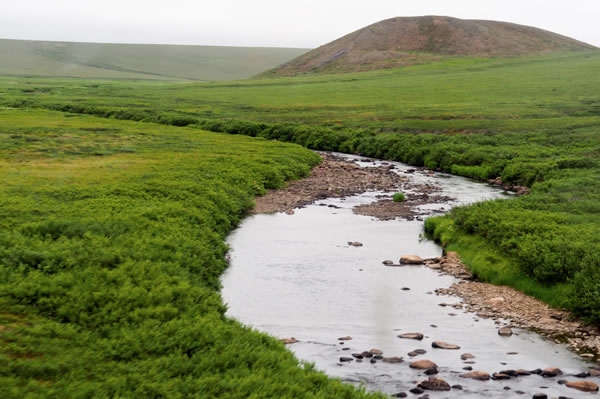
April 6, 2018
Outdoor Learning Reaches a Larger Classroom
The benefits of outdoor learning have been in the news for the past few years. Studies have found that going outdoors to learn science connects students and teachers to the natural environment. It reaches these students in new and different ways and gives them real world examples of what they are learning about in their classrooms.
Given the aim of the iUTAH project to engage and build a water-wise citizenry, it seemed only fitting that the project partnered with the Natural History Museum of Utah’s Taking Learning Outdoors (TLO) program. Over the six years that the TLO program was active in Utah schools, it was able to equip 98 K-12 teachers with resources, information, and professional insight that has helped them bring their local watershed into their classrooms.
Supported by iUTAH and facilitated by NHMU, teachers in TLO cohorts participated in a year-long series of workshops led by science and education experts from around Utah. Teachers examined their local watershed and learned how to most effectively incorporate these natural science into their curriculum. These teachers then brought what they learned into their classrooms, helping the program to reach over 12,000 students. When asked about their experience, one teacher said, “I feel that my confidence has increased as a result of realizing that science is all about using observations to describe and define our natural environment. Observations cannot be wrong. They can become more specific, defined and refined over time but they aren’t wrong. This helped me to be less afraid of science and love it more.”
A lasting legacy of the TLO program is the curriculum and insights available on NHMU’s website. Now, these lessons have been made available to encourage teachers to continue to take their classes outside by providing resources and lesson plans to help teachers feel more comfortable teaching outdoors. These lessons even include resources developed by Nancy Bo Flood, the author of Water Runs Through This Book, a book supported by iUTAH and given to many libraries, schools, and students throughout the state.
While the TLO program has ended its formal teaching program, banners now hang in 50 schools across the state that participated in the program. These banners encourage use of the lessons developed over the past five years. They also remind TLO teachers to share what they learned, helping their students to take an active interest in their watershed in a multi-disciplinary way.
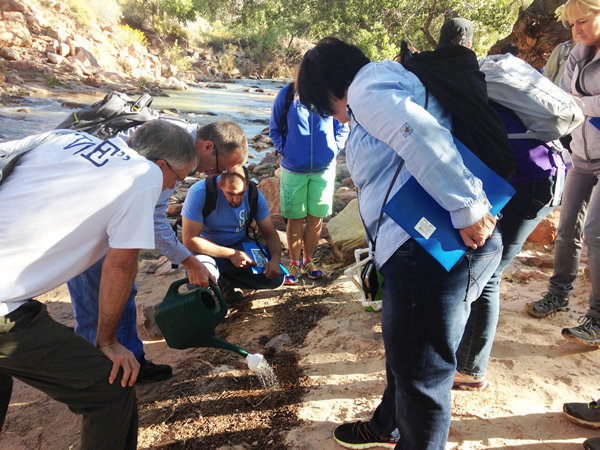
April 2, 2018
Building Cross-Campus STEM Collaboration in Utah
The iUTAH EPSCoR project has built Science, Technology, Engineering, and Math (STEM) capacity in Utah through its Research Catalyst Grant (RCG) program. These competitively funded grants targeted faculty at primarily undergraduate institutions (PUls) involved in water-related research. They also strongly encouraged undergraduate student participation in research, presentations, and publications. What started as seed funding for research evolved to take a more holistic approach including professional development, release time from teaching, and funding for additional equipment and resources. An outreach component of this program also supported 23 outreach events to diverse audiences.
As a result, 20 researchers, 11 of them women, were awarded RCG funding totaling $300,000 over the past five years. The research involved four different PUIs: Southern Utah University, Utah Valley University, Weber State University, and Westminster College.
The research of RCG awardees has captured the attention of larger universities in Utah, as demonstrated in these stories below:
"The RCG grants and participation in iUTAH gave the PUI faculty opportunities to flex their professional muscles through research; it also provided a break from heavy teaching loads,” said one participant in a post-award focus group. Another applicant not receiving an RCG grant said that “the whole RCG process had been instrumental in providing a relatively streamlined, low friction opportunity, which incentivized him to put together a proposal, and providing feedback that strengthened the proposal to the point where it could be competitive in another setting.” The applicant later received funding from a federal agency.
Awardees have taken full advantage of professional development training, opportunities, and funding offered by iUTAH to grow their skills and present their research. Three recipients participated in communications workshops by the Alan Alda Center for Communicating Science, 8 participated in an iUTAH sponsored Broader Impacts Forum, and one recipient was awarded a travel stipend to attend a Council on Undergraduate Research Institute on developing an undergraduate research program at a PUI. The program also supported travel for four students and their mentors to present RCG research at scientific conferences.
iUTAH’s RCG program has also encouraged continuity and synergy among research efforts carried out at PUIs, as evidenced by the publication of a co-authored paper by two non-concurrent RCG recipients. Suzanne Walther from UVU was among the first researchers to receive a RCG award in 2013. After she left the university for another post, Weihong Wang continued Walther’s initial research, and later expanded on the theme by submitting her own successful RCG proposal in 2015. Both researchers published their results, along with other iUTAH collaborators, in a paper titled “The historical records of stable isotopes and trace metals along Utah Lake-Jordan River transition zone, Utah (USA)” through the Utah Geological Association Publication, in 2017.
Interdisciplinary research and cross-campus collaborations has been a hallmark of the iUTAH RCG program. Research projects have involved 111 students to date, representing one third of the iUTAH undergraduate student cohort. Additionally, 14 of the researcher awards involved collaborations with at least one of three academic research universities in the state. Three also involved collaborations with other PUIs. To date, RCGs have generated 7 publications, 51 presentations, and 8 submitted grant proposals. Five of these grant proposals were awarded, for a total of $169K. Undergraduate students at PUIs throughout Utah were truly the beneficiaries of the RCG program by being involved with faculty mentors in real research and having opportunities not otherwise available to them.
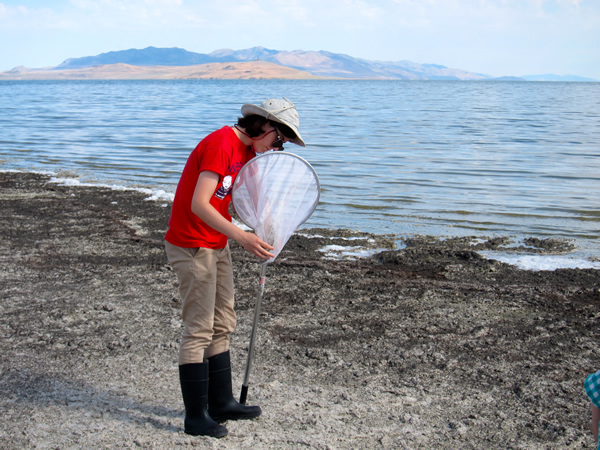
March 19, 2018

Andreas (Andy) Leidolf, iUTAH’s assistant director and project administrator, will be starting a new position as Program Coordinator for the Utah State University Honors Program on April 1. The program involves around 600 students at USU. Similar to his role in iUTAH, the position combines program coordination and administration, with program development and implementation, as well as long-term strategic planning to sustain and grow the program. There may also be some opportunities for teaching and coaching.
While Andy will be missed for his ideas, organizational abilities, and energy that have shaped iUTAH over the past three and a half years, he will continue his connection to various science partnerships that he fostered here. As Executive Director of the Society for Freshwater Science, a position held since January 2018, he oversees the efforts of SFS in promoting further understanding of freshwater ecosystems and the interface between aquatic and terrestrial habitats. Later in 2018, he will start a visiting fellowship with the American Association for the Advancement of Science’s Community Engagement Fellows program, continuing his work with them by writing for publication, mentoring, and teaching of the next cohort group.
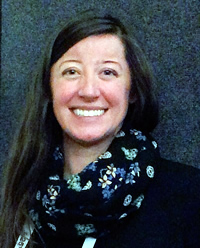
Ellen Eiriksson, iUTAH’s education, outreach, and diversity coordinator, began dividing her iUTAH time with the Natural History Museum of Utah as their Citizen Science Liaison in January. She has been helping to support NHMU's citizen science programming, including the museum's effort to create and coordinate a statewide citizen science community.
iUTAH will soon welcome their newest member as Ellen and Dave Eiriksson, iUTAH’s GAMUT instrumentation technician at the University of Utah, are expecting a baby this month, March 2018. This means that Ellen will be out of the office through mid-June on maternity leave. Afterwards, she will be returning to wrap-up EOD-related items through the end of the project on July 31.


